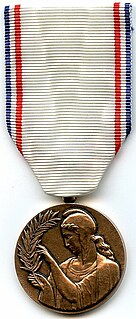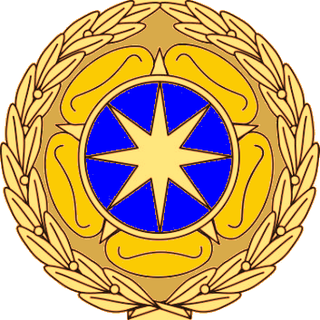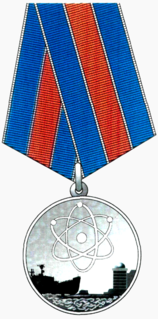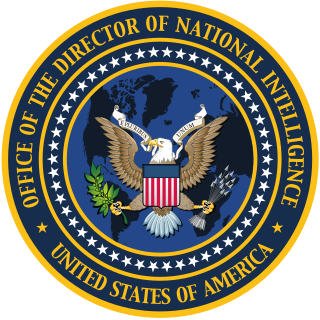
The Legion of Merit (LOM) is a military award of the United States Armed Forces that is given for exceptionally meritorious conduct in the performance of outstanding services and achievements. The decoration is issued to members of the seven uniformed services of the United States as well as to military and political figures of foreign governments.

The Defense Meritorious Service Medal (DMSM) is an award bestowed upon members of the United States military by the United States Department of Defense. In the order of precedence of the United States Armed Forces, it is worn between the Purple Heart and the Meritorious Service Medal. The medal is awarded in the name of the Secretary of Defense to members of the Armed Forces who, while serving in a joint activity, distinguish themselves by non-combat outstanding achievement or meritorious service, but not of a degree to warrant award of the Defense Superior Service Medal.

The Military Outstanding Volunteer Service Medal (MOVSM) is a military award which was created under Executive Order 12830 by George H. W. Bush on January 9, 1993. The medal was designed by the Institute of Heraldry and was first issued in December 1993.

The Spanish War Service Medal was a United States military medal of the U.S. Army which was established by an act of the U.S. Congress on 9 July 1918. The medal recognizes those members of the Army and of the U.S. Volunteers who performed active duty during the Spanish–American War, but did not qualify for the Spanish Campaign Medal.

The National Intelligence Distinguished Service Medal (NIDSM) is a decoration awarded for service to the United States Intelligence Community. The decoration is awarded to any member or contributor to the National Intelligence Community, either civilian or military, who distinguishes themselves by meritorious actions to the betterment of national security in the United States of America, through sustained and selfless service of the highest order.
Awards and decorations of the United States Air Force are military decorations which are issued by the Department of the Air Force to Air Force service members and members of other military branches serving under Air Force commands. Of all five branches of the United States Armed Forces, the United States Air Force currently maintains the highest number of active awards and decorations, including many without equivalent in any other service.
Awards and decorations of the United States government are civilian awards of the U.S. federal government which are typically issued for sustained meritorious service, in a civilian capacity, while serving in the U.S. federal government. Certain U.S. government awards may also be issued to military personnel of the United States Armed Forces and be worn in conjunction with awards and decorations of the United States military. In order of precedence, those U.S. non-military awards and decorations authorized for wear are worn after U.S. military personal decorations and unit awards and before U.S. military campaign and service awards.

The Meritorious Public Service Medal formerly the Outstanding Civilian Service Award is the third highest honor within the public service awards scheme of the Department of the Army that can be awarded to a private citizen.
The National Intelligence Medal of Achievement is an award that was presented to members of the United States Intelligence Community, both civilian and military, to recognize significant acts of service to the community as a whole. The National Intelligence Medal of Achievement was replaced with the equivalent National Intelligence Exceptional Achievement Medal, during the restructuring of the National Intelligence Community Awards (NICA) Program, with the revision of Intelligence Community Directive 655 in 2012.

The Distinguished Public Service Medal, formerly the Department of the Army Decoration for Distinguished Civilian Service was established by directive of the Secretary of the Army in May 1956. This award consists of a gold medal, lapel button and certificate. This award recognizes distinguished service toward the accomplishment of the Army's mission.

The Department of Commerce Silver Medal is the second highest of three honor awards of the United States Department of Commerce. Since 1949, the Silver Medal is presented by the Secretary of Commerce for exceptional service. The award may be presented to an individual, group, or organization in the Commerce Department for noteworthy or superlative contributions which have a direct and lasting impact with the department.

The Medal of French Gratitude was a French honour medal created on 13 July 1917 and solely awarded to civilians. The medal was created to express gratitude by the French government to all those who, without legal or military obligation, had come to the aid of the injured, disabled, refugees, or who had performed an act of exceptional dedication in the presence of the enemy during the First World War. The creation of this distinction was mainly the result of unsuccessful offensives of General Nivelle in 1917 and the serious crisis of confidence in France. The French government thus wanted to thank those who, despite the crisis, were always volunteering. It has three classes: bronze, silver, and gold. Nearly 15,000 people and communities were recipients of this award. The medal is no longer awarded, the last award was on 14 February 1959.

The Meritorious Civilian Service Award is the second highest award granted by the Secretary of the Army or a major Army commander to civilian personnel. It consists of a medal, lapel button, and citation certificate. Nominees must have established a pattern of excellence, normally demonstrated by the receipt of lower level awards. The award is comparable to the military Legion of Merit.

The Department of the Army Decoration for Exceptional Civilian Service is the highest award that may be bestowed by or on behalf of the Secretary of the Army to Army civilian employees. The medal was approved by the War Department 29 December 1945. This award consists of a gold medal, lapel button and certificate. A ribbon bar and miniature medal is also available for private purchase.

The Polish Army Medal was established by Poland on 3 September 1999 to recognize service to the Polish Army by foreign civilians and military personnel. The medal is presented in three grades Gold, Silver, and Bronze by the Polish Minister of National Defence. Most awards are presented to members of allied armed forces, but the medal is also awarded to civilians who contribute to promoting the history and traditions of the Polish Army outside of Poland.

The National Intelligence Meritorious Unit Citation (NIMUC) is an award of the National Intelligence Awards Program, for contributions to the United States Intelligence Community. It may be "...awarded for the collective performance of a unit or group that has resulted in accomplishments of a clearly superior nature and of significant benefit to the Intelligence Community".

The National Intelligence Cross is a decoration of the United States Intelligence Community (IC) awarded under the National Intelligence Awards (NIA) Program by the Office of the Director of National Intelligence (ODNI). It is the highest award presented by the Office of the Director of National Intelligence. It is equivalent of the Central Intelligence Agency's Distinguished Intelligence Cross.
The Secretary of Transportation Outstanding Achievement Medal also known as the Department of Transportation Gold Medal is the highest honorary award of the United States Department of Transportation.
The National Intelligence Superior Service Medal is an award of the National Intelligence Awards Program that recognizes an individual's superior service or a lasting contribution over a long period of time to the United States Intelligence Community and the United States as a whole. The medal ranks below the National Intelligence Distinguished Service Medal, but above the National Intelligence Exceptional Achievement Medal.

The Medal "For Merit in the Development of Atomic Energy" is a state decoration of the Russian Federation aimed at recognising achievements in the nuclear industry. It was established by presidential decree №133 on March 16, 2015, marking the 70th anniversary of the Russian nuclear industry. The decree also established the title "Honored Worker of the Nuclear Industry of the Russian Federation."



















